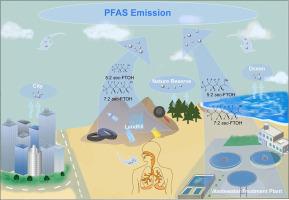Environment International ( IF 10.3 ) Pub Date : 2022-07-26 , DOI: 10.1016/j.envint.2022.107434 Huiju Lin 1 , Jia-Yong Lao 1 , Qi Wang 1 , Yuefei Ruan 2 , Yuhe He 3 , Patrick K H Lee 4 , Kenneth M Y Leung 2 , Paul K S Lam 5

|
Per- and polyfluoroalkyl substances (PFAS) have been applied in numerous industrial and consumer products, the majority of which flow into waste management infrastructures (WMIs) at the end of their life cycles, but little is known about atmospheric releases of PFAS from these facilities. In this study, we addressed this key issue by investigating 49 PFAS, including 23 ionic and 26 neutral and precursor PFAS, in the potential sources (n = 4; within or adjacent to WMIs) and reference sites (n = 2; coastal and natural reserve sites) in urban and rural areas of Hong Kong, China. Duplicate samples of air and size-segregated particulate matter were collected for 48 h continuously using a 11-stage Micro-Orifice Uniform Deposit Impactor (MOUDI). In general, fluorotelomer alcohols (FTOHs) and perfluoroalkane sulfonamides were the predominant PFAS classes found across sampling sites. We also demonstrated the release of several less frequently observed semivolatile intermediate products (e.g., secondary FTOHs) during waste treatment. Except for perfluorooctane sulfonate, the size-segregated distributions of particulate PFAS exhibited heterogeneity across sampling sites, particularly in the WMIs, implying combined effects of sorption affinity and emission sources. A preliminary daily air emission estimation revealed that landfill was a relatively important source of PFAS relative to the wastewater treatment plant. A simplified International Commission on Radiological Protection model was used to estimate lung depositional fluxes, and the results showed that inhaled particulate PFAS were mainly deposited in the head airway while fine and ultrafine particles carried PFAS deeper into the lung alveoli. The cumulative daily inhalation dose of gaseous and particulate PFAS ranged from 81.9 to 265 pg/kg/d. In-depth research is required to understand the health effect of airborne PFAS on workers at WMIs.











































 京公网安备 11010802027423号
京公网安备 11010802027423号